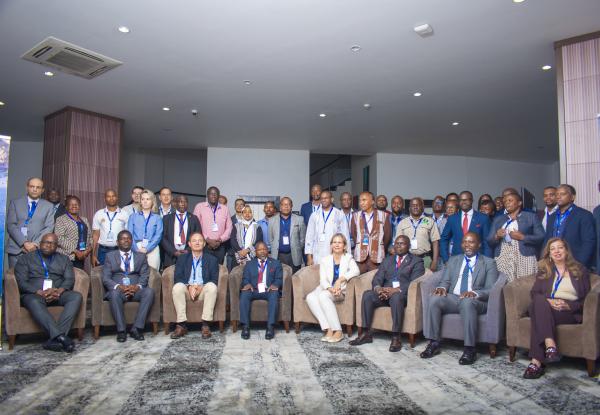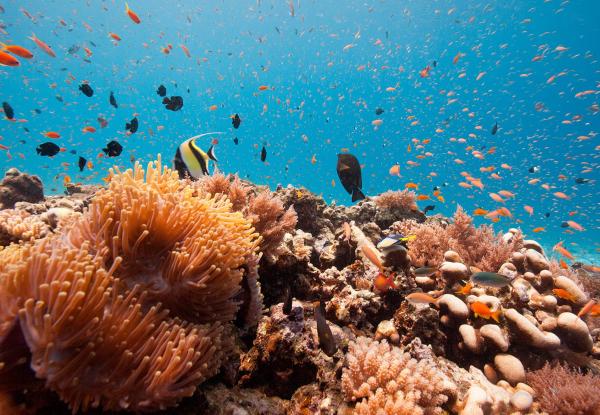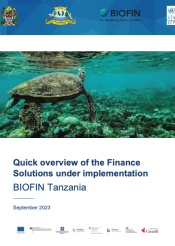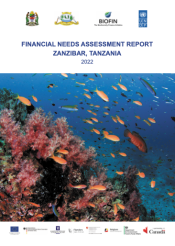Tanzania
Welcome to Tanzania, the vast East African nation that embraces the Indian Ocean. This diverse land is home to iconic features such as Africa's towering peak, Kilimanjaro, the expansive Lake Victoria, and the world-renowned Ngorongoro Crater. Tanzania's beauty thrives in its numerous protected areas – 16 National Parks, 3 Biosphere Reserves, 4 World Heritage Sites, 28 Game Reserves, 42 Game Controlled Areas, 38 Wildlife Management Areas, 109 Forests, 4 Marine Parks, and 17 marine reserves. With a staggering four million wild animals within its borders, Tanzania boasts the highest concentration of animals per square kilometer globally. Nevertheless, the country is one of fifteen facing the most significant threats to its biodiversity, with over 900 species classified as endangered according to the IUCN Red List of 2013.
An expression of interest to implement BIOFIN was received from Tanzania in February 2018. The Biodiversity Finance Initiative (BIOFIN) was first piloted in Zanzibar, an autonomous part of the United Republic of Tanzania (URT), to develop the Biodiversity Finance Plan (BFP) as a key tool for effective biodiversity financing.
Zanzibar is celebrated for its stunning marine, coastal, mangrove, and terrestrial ecosystems, each teeming with diverse biodiversity. Zanzibar nurtures essential socio-economic activities like fishing, seaweed farming, and tourism, all rooted in its natural resources. Yet, challenges loom large, including climate fluctuations, invasive species, habitat decline, overfishing, and institutional barriers, posing threats to its delicate ecological balance.
In a promising move, the Zanzibar government embraced the Biodiversity Finance Plan (BFP) in 2022, a strategic step to bridge financial gaps in preserving this unique biodiversity. The BFP has identified pivotal financial strategies to address these gaps and bolster the safeguarding of Zanzibar's precious biodiversity.
The spotlight shone brightly on June 22, 2023, as the government officially launched the BFP in the presence of esteemed stakeholders and the UNDP Co. This groundbreaking plan meticulously outlines thirteen paramount financial solutions, detailed below, poised to effectively counter the current financial challenges hindering comprehensive biodiversity conservation in Zanzibar.
In the time frame spanning from 2018 to 2027, the BIOFIN Programme was initiated as a pilot initiative within Zanzibar. It has achieved notable success, culminating in the creation of the BFP in November 2022. These pivotal reports encompass the Policy and Institutional Review (PIR), the Biodiversity Expenditure Review (BER), and the Finance Need Assessment (FNA).
Forecasts extending over a five-year span (from 2023/24 to 2027/28), based upon the findings of the Biodiversity Expenditure Review (BER) and Finance Need Assessment (FNA), indicate a calculated requirement of USD 69.4 million. Concurrently, the estimated financial shortfall stands at USD 43.41 million.
These comprehensive reports collectively laid the groundwork for the development of the Biodiversity Finance Plan (BFP). This comprehensive plan was formally inaugurated on June 22nd, 2023, through official channels. The occasion witnessed the presence and recognition of crucial stakeholders, along with the UNDP Co.
At its essence, the BFP serves as a meticulously devised strategy, outlining 13 prioritized financial solutions, itemized below. The implementation of these solutions is anticipated to substantially mitigate the identified financial gap concerning the conservation of biodiversity within Zanzibar. These solutions are:
- Crowdfunding for restoration of degraded key forests and/mangroves in selected Community Forest Management Areas (CoFMAs);
- Establish Payment for Ecosystem Services (PES) Programme for CoFMAs and other forests generating significant water ecosystem service.
- Repurpose/Reform potentially harmful subsidies in the fisheries sector;
- Establish and operationalize public-private partnership (PPP) framework for “Re-greening Zanzibar Program” (coastal and inland areas);
- Repurpose potentially harmful subsidies for sustainable seaweed farming;
- Secure Debt-for-nature swaps for sustainable BLUE economy (coral reefs restoration);
- Establish Blue Fund for BLUE Economy implementation;
- Establish crowdfunding for restoration of degraded coastal and beach areas;
- Identify and develop a new program for scaling up of REDD+ initiatives;
- Introduce subsidies for clean energy sources (e.g., gas and electricity) for household energy;
- Increase Corporate Social Responsibility (CSR) contributions from the private sector for biodiversity conservation;
- Review tourist’s entrance fee structure for protected areas and adopt a Digital Voucher System for the fees collection; and
- Review and strengthen the revenue retention framework/Scheme for terrestrial PAs and Marine Conservation Areas (MCAs).
BIOFIN Tanzania secured a budget to implement the following Finance solutions (detailed descriptions are provided in the “overview of the implemented Finance solutions” – cf Publications):
- Review of fees related to protected and marine conservation areas (PMCA’s) and implementation of digital voucher payment system for tourists entering PMCA’s.
- Mainstreaming biodiversity in the PPP framework and implement PPP investment for PAs in Zanzibar
- Mapping and assessment of subsidies potentially harmful to biodiversity in the fisheries sector and seaweed farming.
The Policy and Institutional Review (PIR) for Zanzibar analyzed the biodiversity related policy framework, strategies, trends and drivers for biodiversity degradation and recommends a set of options to support development of Biodiversity Finance Plan. The PIR identified around 25 sectors, agencies, institutions and organizations with direct and indirect mandates, functions and initiatives related to biodiversity resources conservation and utilization. About 15 non-government actors particularly the private sector, NGOs, research and academic institutions were also identified.
The PIR identified key threats and drivers of biodiversity and ecosystem trends in Zanzibar. It also noted that, the National Biodiversity Strategy and Action Plan (NBSAP), ended in 2020, dis not comprehensively address Zanzibar’s unique island ecosystem and biodiversity priorities.
Key recommendations from the PIR laid a basis for Biodiversity Expenditure Review (BER) and the Financial Needs Assessment (FNA) that concurrently culminated in the development of a Biodiversity Finance Plan and Finance Solutions for Zanzibar. Several recommendations, grouped in three categories, were geared to enhance, improve, amend or modify existing policies and practices to achieve positive and prevent negative biodiversity and ecosystem status and trends:
- Those aiming to improve Biodiversity Conservation by integrating biodiversity issues in national planning, integration and synchronized policy approaches to undo institutional overlaps and enhance efficient resources mobilization;
- Those aiming to enhance participatory biodiversity conservation through co-management approaches, promoting and supporting a community livelihoods and sustainable income generating initiatives;
- Those aiming to facilitate sustainable use of natural resources both on land and in the marine environment with specific actions on enhancing public-private sector engagement through strengthening the private sector engagement.
Biodiversity Expenditure Review (BER) outlines biodiversity-relevant activities from budgets of Ministries, Departments and Agencies (MDAs) as well as budgets of non-government entities. This BER report aims to: i) estimate past and future biodiversity expenditures across the public, private, and civil society sectors, ii) identify what activities these biodiversity expenditures are targeting and map them according to biodiversity categories, and iii) determine policy alignment and spending efficiencies for the main biodiversity actors. The budget allocation with respect to the BIOFIN categories was mostly on promoting sustainable use; Biodiversity development and planning; biodiversity awareness and knowledge, restoration of marine and forest areas; Green economy, and pollution management.
Overall, budget allocation attributed to biodiversity expenditure was extremely low, less than half of a percent of the total government budget. The trends for budget allocation and actual expenditure for most MDAs indicated a declining allocation and more so for the development budget. The Private sector plays a significant role in biodiversity-related initiatives. The forecasted biodiversity expenditure under the most likely scenario indicated that an average of USD 4,655,659 per year will be spent by both government and non-government entities in the next five years based on the financial data collected from different sources.
The Zanzibar Biodiversity Strategy and Action Plan (ZABSAP) is highly recommended to help for a systematic framework to plan, fundraise and track the performance of national biodiversity goals as well as financing biodiversity-related activities. It will ensure biodiversity is prioritized in the respective sectors and in the government planning processes. A mechanism and monitoring framework to track biodiversity financing by the private sector and other non-government entities are recommended.
The Financial Needs Assessment (FNA) is a comprehensive estimate and analysis of the human resources, capital investments and financial resources needed to fund biodiversity-related activities in Zanzibar. It intended to achieve the following objectives in attaining eighteen (18) identified targets for biodiversity conservation and management in Zanzibar:
- Reviewing national biodiversity targets to identify strategies and actions needed to achieve the stated targets;
- Translating identified strategies and actions into “costable actions” with clear results;
- Preparing a detailed budget for each costable action;
- Consolidating budgets for each costable action into a national budget for meeting biodiversity financing needs; and
- Estimating the finance gap between business-as-usual biodiversity expenditure projections (from the BER) and financial needs identified in the FNA.
The projected biodiversity financing need is USD 69,413,043 (using the exchange rate of 1 USD=TZS 2310), at an average of USD 13,882,608 per year. Large portion of the Finance needs was located to Target 4 (22.2%), that “by 2028, investments in systems of production and consumption based on sustainable, eco-friendly practices increased”, followed by Target 7 (15.1%) that, by 2028, all forms of pollution from water and land-based activities are brought to levels that are non-detrimental to biodiversity-ecosystem functions”, and Target 5 (14.9%) that, “by 2028, the rate of degradation and fragmentation of ecosystems and the loss of habitats is significantly reduced”. It was further found that, based on the biodiversity financing needs by BIOFIN categories (2022/23 to 2027/28), the biodiversity and Development planning category accounts for 49% of the financing needs and about 70% of the financing gap for biodiversity in Zanzibar. The FNA concludes that, these financial needs require attention. All identified national biodiversity targets require substantial financing. Ensure that institutions, policies, financing mechanisms and procedures are in place/improved and operational. The following are also recommended:
- Close engagements with non-government entities for them to understand that they are an integral part of the biodiversity management efforts in Zanzibar;
- Adopting FNA findings as inputs into the government planning and budgeting exercise. This would help in the efficient allocation of resources required to achieve national biodiversity targets; and
- Zanzibar to develop its own Biodiversity Strategy and Action Plan (ZABSAP).
The BFP in Zanzibar, officially launched on 22nd June, 2023, presents a coherent and comprehensive approaches for mobilizing additional financial resources for biodiversity conservation. It guides on the implementation of the 13 prioritized finance solutions for the next 5 years (2022 – 2026). The FSs were generated through a rigorous consultative approach in accordance with the BIOFIN WorkBook of 2018. In Zanzibar, there is conducive environment for BFP implementations:
- National and International commitments,
- High political will, with enabling policy environment,
- The BIOFIN coordination structure to implement the BFP is well institutionalized, embedded in the First Vice President’s Office, connected to Steering Committee and focal persons at Ministries, Departments and Agencies,
- National BFP Implementation Strategy in place,
- The established Zanzibar Green Legacy Initiative for re-greening Zanzibar,
- The Blue Economy Policy of 2020 and Implementation Strategy, and
- Accomplishing the Marine Spatial Planning (MSP) that focuses on sustainable uses, likely to align any subsidy in the fisheries and seaweed farming.
Generally, the BFP presents that, the Revolutionary Government of Zanzibar experiences a large financial gap in biodiversity conservation. However, it promises that the prioritized 13FSs, if they are well implemented, would reduce the identified finance gap, ultimately contributing to the Zanzibar Vision 2050, SDGs and the AICHI Biodiversity Targets. To realize this, integrated efforts are needed from public and private sectors, CSOs and partners for effective implementations.




